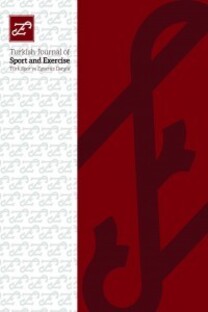A comparison between Aba Wrestling and Judo within technical aspect
In times when survival and wars depended upon physical strength and superiority, sport has almostconstituted a period of preparation for wars. As a matter of fact, it is seen through an analysis of documentsand records that societies of those times were constantly involved in practices for developing and maintainingthe physical strength. As being one of the wrestling kinds that is performed by wearing clothes, Aşırtmalı AbaWrestling expresses itself as an outward reflection of spiritual and physical needs of people as a whole both inprevious times and today. It also faces us as a cultural accumulation of Turkish people in their daily lives andvalues within social dimensions. In other words, practicing wrestling in times when Turks have lived inCentral Asia has grown out of the need for the unity of spiritual sentiments and thoughts with body byremaining bound to their living standards and cultural norms of those times. The fundamental aim of thisstudy is to determine and to present the rules, basic games/techniques of aba wresting played in Gaziantep andJudo. These issues, which have been lacking in previous studies, will be filled in this study and therefore, itwill constitute importance for the research. In aba wrestling, games are performed standing. Many of thesegames hold precise similarities with Judo. Judo, which has been a popular sport and gradually becomingwidespread in Anatolia in recent years, is considered to be a sport unique to Japanese and Far East Asians. Inthis research, historical and descriptive methods have been used; literature scan and method of interviewingexperts in collecting data about aba wrestling have been employed.
-
In times when survival and wars depended upon physical strength and superiority, sport has almost constituted a period of preparation for wars. As a matter of fact, it is seen through an analysis of documents and records that societies of those times were constantly involved in practices for developing and maintaining the physical strength. As being one of the wrestling kinds that is performed by wearing clothes, Aşırtmalı Aba Wrestling expresses itself as an outward reflection of spiritual and physical needs of people as a whole both in previous times and today. It also faces us as a cultural accumulation of Turkish people in their daily lives and values within social dimensions. In other words, practicing wrestling in times when Turks have lived in Central Asia has grown out of the need for the unity of spiritual sentiments and thoughts with body by remaining bound to their living standards and cultural norms of those times. The fundamental aim of this study is to determine and to present the rules, basic games/techniques of aba wresting played in Gaziantep and Judo. These issues, which have been lacking in previous studies, will be filled in this study and therefore, it will constitute importance for the research. In aba wrestling, games are performed standing. Many of these games hold precise similarities with Judo. Judo, which has been a popular sport and gradually becoming widespread in Anatolia in recent years, is considered to be a sport unique to Japanese and Far East Asians. In this research, historical and descriptive methods have been used; literature scan and method of interviewing experts in collecting data about aba wrestling have been employed
___
- Erkal M, Güvan O, Ayan D. A Sociological Perspective of Sport, Extented 3rd Issue, Istanbul: Der Publishing, 1998: 19.
- Kar M. An interview made by Hacı Murat Sahin in July 24, 1998 in Gaziantep about Rules and Techniques of Judo, 1998.
- Kaygısız S. An interview made by Hacı Murat Sahin in May 03, 1998 in Gaziantep about Rules and Techniques of Judo, 1998.
- On M. A handbook for Coaches. Ankara: B.T.S.G.M., Judo Federation, 1986: 33-48.
- Sahin HM. A research about Aşırtmalı Aba Wrestling in Gaziantep. Gazi University, Health Sciences Institute, Physical Education and Sports Degree, unpublished Master’s Thesis, Ankara, 1999.
- Sahin HM. Aba Wrestling in Turkish Sports Culture. Gaziantep Sports club publishing, Issue No: 4, Ankara: Nobel Publishing House, 2004: pp. 2.
